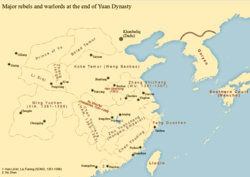| 1363–1371 |
 Ming Xia at the Yuan dynasty's end |
| Capital | Chongqing |
|---|
| Government | Monarchy |
|---|
| Emperor | |
|---|
|
• 1363–1366 | Ming Yuzhen |
|---|
• 1366–1371 | Ming Sheng |
|---|
| |
| History | |
|---|
|
• Established | 1363 |
|---|
• Disestablished | 1371 |
|---|
| |
| Preceded by | Succeeded by |  | Yuan dynasty | | | Ming dynasty |  | | |
| Today part of | China |
|---|
The Ming Xia (明夏; 1363–1371), officially the Great Xia, was a short-lived Chinese dynasty in modern Sichuan and Chongqing during the chaotic late Yuan dynasty. It was founded by the Red Turban rebel general Ming Yuzhen whose army expelled Yuan loyalists from the region in the late 1350s.
In 1363, Ming declared himself Emperor of Great Xia, with the capital in Chongqing. He tried to conquer Yunnan from the warlord Basalawarmi but failed. After his death in 1366, his teenage son, Ming Sheng, succeeded him, but the empire began to disintegrate into regional military commands. In 1371, the Ming dynasty under emperor Zhu Yuanzhang made a two-pronged attack and conquered Ming Xia relatively easily. Ming Sheng surrendered, was exiled to Goryeo, and then became the progenitor of the Korean Namwon Seung clan, Yeonan Myeong clan and Seochok Myeong clan.
References
- (in German) Die Xia-Dynastie in Sichuan (1362-1371)
  | This article related to the history of China is a stub. You can help Wikipedia by expanding it. |



















